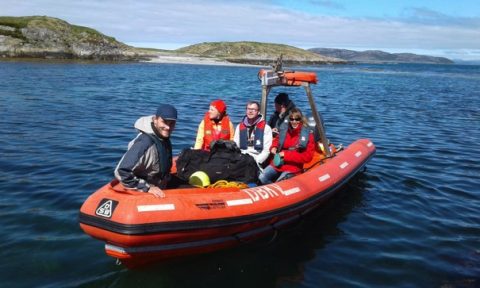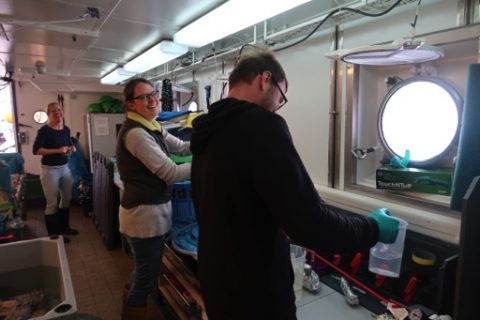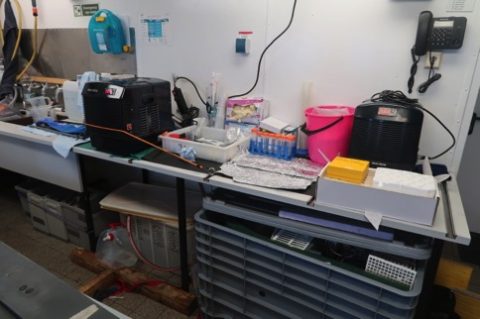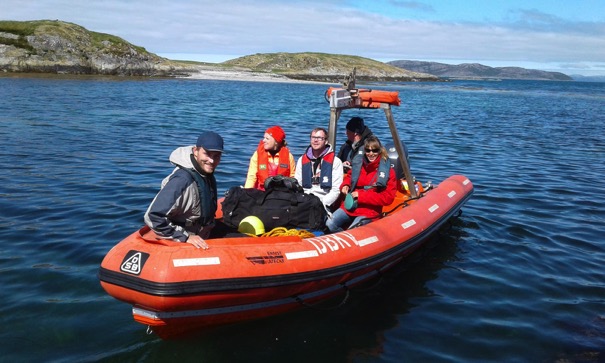[German translation below]
Collaboration of the Scientific Center of Monaco
The Scientific Center of Monaco (CSM) is participating in an oceanographic research expedition with the German research vessel RV Poseidon in Norway this July for 15 days. Led by Janina Büscher from GEOMAR – Helmholtz Centre for Ocean Research, one of the goals of this mission is to collect scientific data about the deep sea coral Lophelia pertusa in four different locations of the Norwegian coastal and offshore waters. Doctors Christine Ferrier Pages and Stéphanie Reynaud from the CSM are working on ecophysiological aspects of Mediterranean deep sea corals since several years and are happy to expand their field of work to Norwegian cold-water coral reefs. Me, I am laboratory technician in the Coral Ecophysiology group of CSM joining this research cruise for the following purposes.
The scientific group of Monaco has several aims during this expedition: the first consists of collecting corals in order to determine parameters like lipids, proteins and carbohydrates in the coral tissues of L. pertusa from different populations. The other aspects are on-board experiments with incubation of coral fragments from the different reefs in order to assess the carbon budget and mucus degradation processes. The last goal is to perform a feeding experiment with labelled food sources (Artemia sp.). The “labels” with which the corals are marked through their given food sources are the naturally rarely enriched isotopes of carbon and nitrogen (13C and 15N), which can be traced back in the tissue compartments of the corals after consumption. Moreover, I support the general daily cruise tasks on board including water filtration for zooplankton analysis.
Collection of the corals is done with the submersible JAGO from GEOMAR institute, which can dive to a maximum of 400 meters. For each dive, the submersible collects the samples needed by means of a manipulator arm. The entire dive is recorded by video documentation through a camera attached in front of the window in JAGO.
Me and two other scientists, Nico and Tina, joined the cruise a couple of days later than start from Bergen and boarded the RV POSEIDON through dinghy from the island Nord Leksa in the outer Trondheim Fjord. Since only two ferries approach this island twice a day, we had to arrive one day before embarkation, since pick-up could take place anytime on the 4th of July. However, Nord Leksa is a beautiful and peaceful place with only two farmers living there permanently. We stayed overnight in an accommodation on a farm surrounded by lots of birds and some otters, which show up from time to time at the coast.

Tendering with dinghy to POSEIDON from the island Nord Leksa to join the POS525 cruise. Picture: Magali Boussion.
Once onboard, Janina and the whole crew welcomed us. I started my duties by doing three water filtrations corresponding to a JAGO dive with the help of Sandra Maier from NIOZ. The water was collected using a CTD made of 12 10L Niskin bottles, which collected the water at ca. 160 m depth, ca. 10 – 20 m above the reef. We filtered water through different sized mesh and filters to analyse the abundance of different zooplankton and phytoplankton groups. The plankton will then be analysed for its natural isotopic signature in ∂13C and ∂15N. The comparison with the isotopic signature of the coral tissue will help us understand the type of prey on which corals are feeding.

Water sieving on deck of RV POSEIDON. Picture: Magali Boussion.

Water filtration in the lab of RV POSEIDON. Picture: Magali Boussion.
After water filtration, I collected mucus from three different corals colonies from the Nord Leksa reef in order to determine the amount of particulate and dissolved organic carbon released by the corals. Afterwards, the mucus will be incubated for 48 hours to assess its degradation rate by the mucus-associated bacteria.

On-board experimental set-up for incubation studies. Picture: Magali Boussion.
Yesterday I finished the incubation of 5 samples for the carbon budget and finally I am trying to adapt 5 other samples to feed the corals with labelled prey. So far for this last experiment, the polyps are not opening enough to feed then, but I am positive for the polyps of the corals to show up in the coming days for me to feed them.
Magali Boussion
Kooperation mit dem Wissenschaftszentrum in Monaco
Das Scientific Center of Monaco (CSM) beteiligt sich an einer ozeanographischen Expedition auf dem deutschen Forschungsschiff FS POSEIDON. Das Hauptziel, der von Janina Büscher (GEOMAR) geleiteten Fahrt, ist es Daten über die Tiefsee Koralle Lophelia pertusa aus vier verschiedenen Riffen entlang der Norwegischen Küste zu sammeln. Meine Kollegen Christine Ferrier-Page und Stéphanie Reynaud vom CSM arbeiten schon seit einigen Jahren an Tiefseekorallen aus dem Mittelmeer mit besonderem Augenmerk auf ökophysiologischen Aspekten und sie sind glücklich ihre Forschung auf norwegische Riffe auszudehnen. Ich arbeite als Labortechnikerin in der Arbeitsgruppe Coral Ecophysiology (Korallen Ökophysiologie) am CSM und nehme an dieser Forschungsreise für folgende Zwecke Teil.
Unsere Arbeitsgruppe hat während dieser Expedition mehrere Ziele. Zum einen sollen Korallen aus ihrer natürlichen Umgebung gesammelt werden um Parameter wie Lipide, Proteine und Kohlenhydrate zu messen und zwischen verschiedenen Populationen zu vergleichen. Zum anderen sollen durch Bord-Inkubationsexperimente der Kohlenstoffhaushalt und Mukus-Abbauprozesse (von Korallen angesonderter Schleim, wichtig für Stoffaustausch) beobachtet und bewertet werden. Zusätzlich führe ich Fütterungsversuche mit „markiertem“ Futter (Artemia sp.) an den Korallen durch. Die Markierung erfolgt durch natürlich vorkommende, radiogene Isotope von Kohlenstoff und Stickstoff (13C und15N). Dadurch kann der Weg, den die Nährstoffe durch das Gewebe der Korallen nehmen, bestimmt werden. Natürlich unterstütze ich auch die anderen in ihren Aufgaben wie zum Beispiel durch Wasserfiltration für Zooplanktonanalysen.
Gesammelt werden die Korallen mit dem Forschungstauchboot JAGO, das vom GEOMAR gebaut wurde, und bis zu 400 m tief tauchen kann. Für jeden Tauchgang schreibt Janina eine „Einkaufliste“ mit den Wünschen der Wissenschaftler, die von Jürgen, dem JAGO-Piloten, minutiös abgearbeitet wird. Er sammelt die Korallen mithilfe eines metallenen Arms (Manipulator) vom Meeresboden und bringt sie in seinem „Einkaufskorb“ an die Oberfläche wo sie schon sehnsüchtig erwartet werden. Der gesamte Tauchgang wird außerdem durch eine Videokamera im Frontfenster von JAGO aufgezeichnet. Wasserproben aus der Umgebung der gesammelten Korallen werden über die CTD gesammelt, die im letzten Artikel noch vorgeführt und näher erklärt wird.
Zwei weitere Wissenschaftler, Nico und Tina, und ich haben uns der Expedition erst ein paar Tage nach dem Auslaufen des Schiffes aus Bergen angeschlossen. Dazu wurden wird von einem kleinen Schlauchboot von der Insel Nord-Leksa im Trondheimfjord abgeholt. Da die Insel sehr abgelegen liegt und täglich nur durch 2 Fähren vom Festland zu erreichen ist, mussten wir schon einen Tag vor der geplanten Abholung anreisen. Da die Insel (Einwohnerzahl: 4) wunderschön ist und es neben Ottern und Vögeln noch einiges anderes zu entdecken gab, war das aber nicht weiter schlimm. Übernachten konnten wir auf der einsamen Insel im Haus eines ansässigen Farmers.
An Bord des Schiffes wurden wir erstmal von Janina, der gesamten Crew und leckerem Kuchen begrüßt. Dann ging es auch schon direkt los und ich habe mit meinen Arbeiten an Bord begonnen und Wasserproben mit Sandra Maier vom NIOZ filtriert. Das Wasser wurde mithilfe der CTD aus einer Tiefe von ca. 160 m, 10 m über dem Riff gesammelt. Die Wasserproben wurden von uns durch verschieden feine Filter gefiltert um die Häufigkeit von verschiedenen Phyto- und Zooplankton Gruppen zu ermitteln. Außerdem wird das Plankton auch auf ihre natürliche Kohlen- und Stickstoffisotopie untersucht. Der Vergleich mit der Isotopensignatur des Korallengewebes erlaubt uns Rückschlüsse auf die Art von Nahrung zu ziehen, von denen sich Korallen ernähren.
Nach dem Filtern, nahm ich noch Proben vom abgesonderten Schleim der Korallen um die Mengen an partikulärem und gelösten organischen Kohlenstoff darin zu bestimmen. Danach wird der Schleim noch 48 Stunden inkubiert um die Rate des Abbaus durch Bakterien zu bestimmen.
Gestern habe ich die Inkubation von 5 Proben zur Beestimmung des Kohlenstoffhaushalts in Laboratorien zu Hause nach der Fahrt zu bestimmen. Nun bin ich bereit, die Korallen mit der markierten Nahrung zu füttern. Zurzeit scheinen die Korallen noch nicht sehr hungrig zu sein, da sie ihre Polypen noch nicht weit genug geöffnet haben, aber ich bin guter Dinge das sich dies in den nächsten Tagen ändern wird.
Magali Boussion
